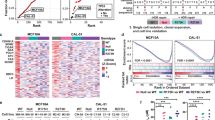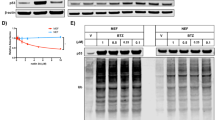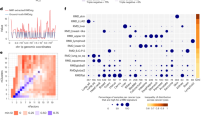Abstract
P53 is inactivated in tumors by mechanisms other than mutations in the p53 gene itself. To gain insight into the mechanisms by which this inactivation occurs, we chemically mutagenized A1-5 cells expressing high levels of temperature sensitive p53val135 (tsp53) and selected for clones that were capable of growth at the permissive temperature for p53 activation. We expanded 22 clones (ALTR cells for A1-5 Low Temperature Resistant) that could grow at the permissive temperature. Most exhibited cytoplasmic sequestration as the mechanism by which p53 was inactivated. We show here that this cytoplasmically sequestered tsp53 protein is maintained in a mutant conformation. Only in clones with nuclear localized p53 is it also expressed in the wild-type conformation suggesting that subcellular localization of tsp53 is important in determining the conformation of the protein. Consistent with this, we show that the changes in conformation of p53 in A1-5 and SK-N-SH cells induced by ionizing radiation also correlate with nuclear translocation of p53. We suggest that nuclear translocation of p53 can result in a change in the conformation from mutant to wild-type but that these may be two separable events.
This is a preview of subscription content, access via your institution
Access options
Subscribe to this journal
Receive 50 print issues and online access
$259.00 per year
only $5.18 per issue
Buy this article
- Purchase on Springer Link
- Instant access to full article PDF
Prices may be subject to local taxes which are calculated during checkout





Similar content being viewed by others
References
Bosari S, Viale G, Roncalli M, Graziani D, Borsani G, Lee AK and Coggi G. . 1995 Am. J. Pathol. 147: 790–798.
Brown JP and Pagano M. . 1997 Biochim. Biophys. Acta. 1332: O1–O6.
Chen J, Marechal V and Levine AJ. . 1993 Mol. Cell. Biol. 13: 4107–4114.
Davidoff AM, Pence JC, Shorter NA, Iglehart JD and Marks JR. . 1992 Oncogene 7: 127–133.
Foster BA, Coffey HA, Morin MJ and Rastinejad F. . 1999 Science 286: 2507–2510.
Gamble J and Milner J. . 1988 Virology 162: 452–458.
Gannon JV, Greaves R, Iggo R and Lane DP. . 1990 EMBO J 9: 1595–1602.
Goldman SC, Chen CY, Lansing TJ, Gilmer TM and Kastan MB. . 1996 Am. J. Pathol. 148: 1381–1385.
Hainaut P and Milner J. . 1993 Cancer. Res. 53: 1739–1742.
Halazonetis TD, Davis LJ and Kandil AN. . 1993 EMBO J 12: 1021–1028.
Haupt Y, Maya R, Kazaz A and Oren M. . 1997 Nature 387: 296–299.
Kubbutat MH and Vousden KH. . 1998 Mol. Med. Today 4: 250–256.
Levine AJ. . 1997 Cell 88: 323–331.
Levine AJ, Chang A, Dittmer D, Notterman DA, Silver A, Thorn K, Welsh D and Wu M. . 1994 J. Lab. Clin. Med. 123: 817–823.
Livingstone LR, White A, Sprouse J, Livanos E, Jacks T and Tlsty TD. . 1992 Cell 70: 923–935.
Martinez J, Georgoff I and Levine AJ. . 1991 Genes Dev. 5: 151–159.
McLure KG and Lee PW. . 1996 Oncogene 13: 1297–1303.
McLure KG and Lee PW. . 1998 EMBO J 17: 3342–3350.
McLure KG and Lee PW. . 1999 EMBO J 18: 763–770.
Milner J. . 1991a Proc. R. Soc. Lond. B Biol. Sci. 245: 139–145.
Milner J. . 1991b Curr. Opin. Cell. Biol. 3: 282–286.
Milner J. . 1994 Semin Cancer Biol. 5: 211–219.
Milner J and Medcalf EA. . 1990 J. Mol. Biol. 216: 481–484.
Milner J and Watson JV. . 1990 Oncogene 5: 1683–1690.
Milner J, Cook A and Sheldon M. . 1987 Oncogene 1: 453–455.
Moll UM, LaQuaglia M, Benard J and Riou G. . 1995 Proc. Natl. Acad. Sci. USA 92: 4407–4411.
Moll UM, Ostermeyer AG, Haladay R, Winkfield B, Frazier M and Zambetti G. . 1996 Mol. Cell. Biol. 16: 1126–1137.
Moll UM, Riou G and Levine AJ. . 1992 Proc. Natl. Acad. Sci. USA 89: 7262–7266.
Momand J, Zambetti GP, Olson DC, George D and Levine AJ. . 1992 Cell. 69: 1237–1245.
Nigro JM, Baker SJ, Preisinger AC, Jessup JM, Hostetter R, Cleary K, Bigner SH, Davidson N, Baylin S, Devilee P, Glover T, Collins FS, Weston A, Modali R, Harris CC and Vogelstein B. . 1989 Nature 342: 705–708.
Sabapathy K, Klemm M, Jaenisch R and Wagner EF. . 1997 EMBO J. 16: 6217–6229.
Scheffner M, Werness BA, Huibregtse JM, Levine AJ and Howley PM. . 1990 Cell. 63: 1129–1136.
Shaulsky G, Ben-Ze'ev A and Rotter V. . 1990a Oncogene 5: 1707–1711.
Shaulsky G, Goldfinger N, Ben-Ze'ev A and Rotter V. . 1990b Mol. Cell. Biol. 10: 6565–6577.
Shaulsky G, Goldfinger N, Peled A and Rotter V. . 1991a Proc. Natl. Acad. Sci. USA 88: 8982–8986.
Shaulsky G, Goldfinger N, Peled A and Rotter V. . 1991b Cell. Growth Differ. 2: 661–667.
Shaulsky G, Goldfinger N, Tosky MS, Levine AJ and Rotter V. . 1991c Oncogene 6: 2055–2065.
Stephen CW and Lane DP. . 1992 J. Mol. Biol. 225: 577–583.
Wolkowicz R, Peled A, Elkind NB and Rotter V. . 1998 Cancer. Detect. Prev. 22: 1–13.
Zaika A, Marchenko N and Moll UM. . 1999 J. Biol. Chem. 274: 27474–27480.
Zambetti GP and Levine AJ. . 1993 FASEB J. 7: 855–865.
Zerrahn J, Deppert W, Weidemann D, Patschinsky T, Richards F and Milner J. . 1992 Oncogene 7: 1371–1381.
Acknowledgements
We are grateful to Dr Arnold Levine for antibodies PAb 421, 246, 240 and 419 and the University of Arizona College of Medicine, Department of Pathology for the use of their LSM-10 confocal microscope in these studies. This paper is submitted by S Gaitonde in partial fulfillment of the requirements of the Cancer Biology Interdisciplinary program for the PhD degree in Cancer Biology offered by the University of Arizona. This work was supported by grant #CA64842 from the NIH.
Author information
Authors and Affiliations
Rights and permissions
About this article
Cite this article
Gaitonde, S., Riley, J., Qiao, D. et al. Conformational phenotype of p53 is linked to nuclear translocation. Oncogene 19, 4042–4049 (2000). https://doi.org/10.1038/sj.onc.1203756
Received:
Revised:
Accepted:
Published:
Issue Date:
DOI: https://doi.org/10.1038/sj.onc.1203756
Keywords
This article is cited by
-
Acquisition of p53 mutations in response to the non-genotoxic p53 activator Nutlin-3
Oncogene (2011)
-
Analysis of transactivation capability and conformation of p53 temperature-dependent mutants and their reactivation by amifostine in yeast
Oncogene (2008)
-
Exonucleolytic degradation of RNA by p53 protein in cytoplasm
Journal of Molecular Medicine (2008)
-
Genetic analysis of p53 nuclear importation
Oncogene (2007)
-
DNA binding and selective gene induction by different forms of the p53 protein
Oncogene (2007)



